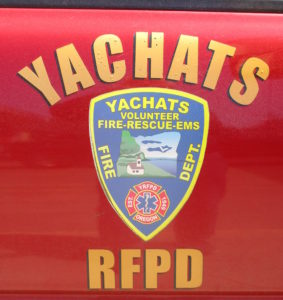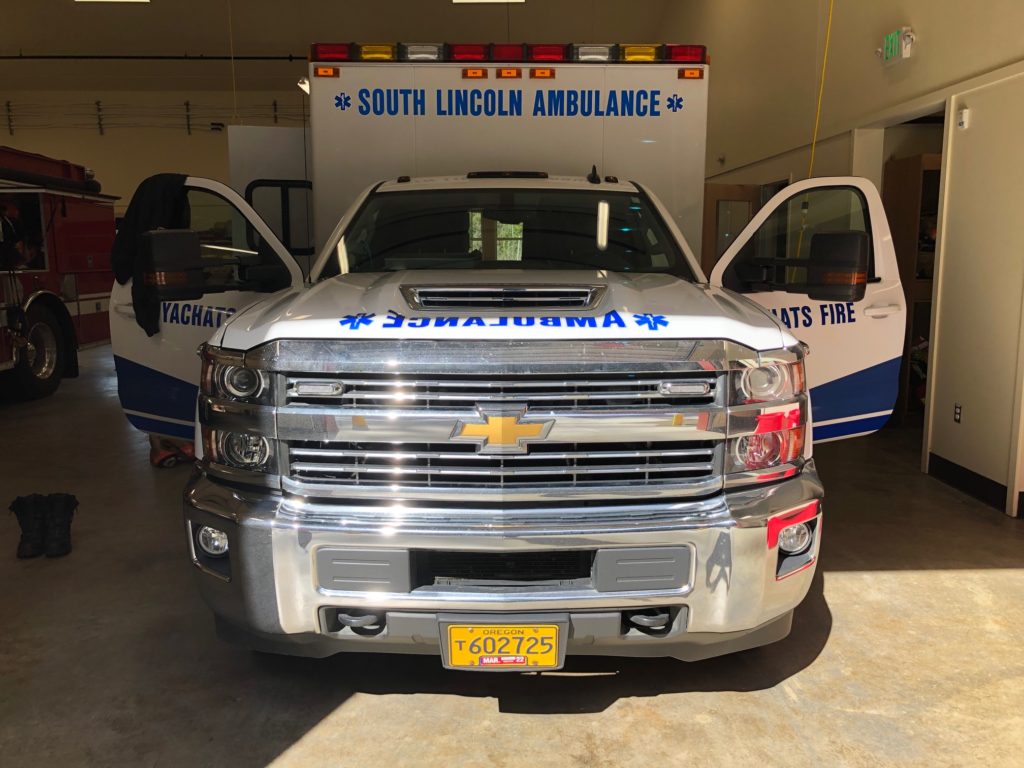
By QUINTON SMITH/YachatsNews.com
The Yachats Rural Fire Protection District should ask voters for more property taxes in November, one longtime board member said last week, because the district is “in trouble” financially.
The district has been operating $400,000 to $500,000 in the red for much of the past three years, drawing from a bank’s line of credit from February to November to pay its bills. When property taxes come rolling in each November, it then pays off the line of credit in December but quickly takes out a new line in January.

The district cannot continue to operate that way, Ed Hallahan told other board members during its monthly meeting Monday, May 10.
“We’re in trouble; we really are,” he said. “We need to get an improved source of money.”

Hallahan said he and board members were distracted the past three years in trying to get the district’s new station located and built. The station was constructed with a $7.7 million bond approved by voters in 2016 – but it’s money that can’t be spent on year-to-year operations.
“While we’re proud of the station, we – and I – screwed up,” he said, by not recognizing financial issues sooner and acting on them. “We are borrowing to stay alive.”
Hallahan said the district used to have a healthy cash carryover each year that could tide the district over from July to November. Then it began taking out of the line of credit, which is not unusual for some jurisdictions that rely almost solely on property taxes, because they had a big influx of money each November.
“All of a sudden our carryover wasn’t making it,” he said, and the line of credit began exceeding the cash carryover.
Hallahan, board member Drew Tracy and fire district administrators Frankie Petrick and Shelby Knife have been meeting as a committee to discuss financial issues. In the next few months it plans to recommend to the board that it take a 61 cent tax levy and ask voters in November to increase it.
“We’re going to have to ask people to help us a bit … we’re going to have to do something to stop borrowing money,” Tracy said.
How the levies work
The district’s yearly operating budget comes from a permanent tax base and two levies which come up for a vote every three years. The levies have not been increased since they were first approved in 1999 and 2008. Between the bond, the tax base and two levies, the Yachats fire district takes up the third-largest portion — 16 percent — of all property taxes levied in Yachats.
Here’s how the levies work:
- The district’s permanent tax base, established in 1997, is 29 cents per $1,000 assessed property value;
- A three-year levy that started in 1999 carries a tax rate of 61 cents per $1,000 of assessed property value; it was last renewed in 2019 by a 3-to-1 vote;
- A three-year levy that started in 2008 is 59 cents per $1,000; it was last approved in May 2018 by a 3-to-1 vote;
- In total, the three levies add up to a tax rate of $1.49 per $1,000 assessed property value or $372 a year on property assessed at $250,000.
The shortage of funds in the fire district’s $1.395 million yearly budget is due to several factors, including:
- It was forced to use $125,000 out of its operating funds in 2018-2019 to repay interest it taken out of a savings account where it had co-mingled money from two tax levies and a $7.7 million bond passed by voters in 2016.
- It spent $423,000 out of yearly operating funds – $85,000 to $95,000 a year for five years – to buy land for the new fire station, instead of using bond proceeds as is usually done elsewhere. The last of monthly payments were made a few months ago. Board members now say using operating funds to buy the land was a mistake.
- While income has remained flat, costs – everything from employee wages, to insurance, to the increased cost of operating the new station – have risen by about 13 percent a year.
The fire district is nearly ready to put its old station in downtown Yachats on the market. It hopes to use proceeds from that sale – but no one is sure what it might sell for or when – to prop up its operating expenses.

Debate over ambulance service
But there’s also another issue facing the fire district that a majority of board members want to discuss as well.
Petrick and Knife also oversee the nonprofit South Lincoln Ambulance, which pays the fire district $150 a month for utilities but uses the fire district’s firefighter/paramedics to staff the ambulance.
All other areas of Lincoln County are serviced by Pacific West Ambulance, a private company that uses its own personnel and charges $1,500 for its basic service. Petrick has said previously that South Lincoln is intended as a community service, charging $850 for basic calls.
Two other neighboring fire districts – Central Oregon Coast Fire & Rescue and the Seal Rock Fire District – are also beginning to grumble more about the number of times their thinly-staffed departments cover for Yachats firefighters while they are manning the ambulance.
Tracy and board member Don Tucker want to bring the ambulance service under the fire department and have gotten some support to discuss that further from board chair Katherine Guenther and longtime member Betty Johnston.
“I understand why South Lincoln Ambulance started years ago,” Tracy said during last week’s meeting. “But it’s time to now consider bringing it under one umbrella.”
“I agree,” said Tucker, who asked that the board create a subcommittee to gather information and see if it could come up with a consolidation plan by this time next year.
“I think it’s worth exploring,” Guenther said.



Enough is enough! I already pay four Yachats RFPD charges on my property taxes totaling $305.88 for my modest cabin, and on a fixed income. This is because of the new fire station, poorly planned and way over budget for a town of less than 800 residents. I lived in an area with over 3000 residents and we had a functional not fancy fire station and, no they did not get bailed out by the tax payers because they did not waste money. Residents there would have marched with torches and pitchforks had they been charged what we are paying in tax levies here. We should be contracting with Fire Med for ambulance service. I still pay for this service because it works on the coast range where I drive and most of the coast EXCEPT Yachats. The cost, $124 a year for air and ground ambulance coverage.